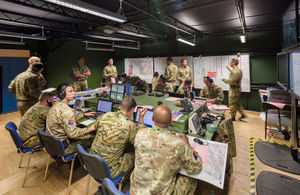Niteworks 3: Developing Joint Battlespace Management capability
To develop a Joint Battlespace Management capability through assurance, competency and future improvement.

A room that shows many service personnel at work in Joint Battlespace Management.
Background
Battlespace Management (BM) is a fundamental enabler for Joint Action as it allows the synchronisation of military capability in time and space to improve overall operational capability, and reduce the incidence of unintended consequences such as fratricide. It is simple in concept but often highly complex to deliver. Previously, BM has been a matter largely dealt with within the ‘stovepipes’ of maritime, land and air operations, but there are increasing encroachments across environmental boundaries and this trend is continuing. In addition, commanders are increasingly aware of the operational advantage that integration across the Joint Force brings.
Niteworks Task
Niteworks was commissioned by Joint Forces Command (JFC), Joint Warfare to provide a critical overview of Joint BM (JBM) and make recommendations to improve assurance, develop a competency framework, supporting toolset and a blueprint for future improvement.
How did Niteworks approach the task?
As industry have the breadth and depth of knowledge of BM across all of the seven dimensions of battlespace and deliver BM training, their input was invaluable in ensuring a truly comprehensive analysis of JBM concepts, doctrine and current practice.
Niteworks conducted one-to-one engagements with key stakeholders, workshops with industry and the user community, and identified a number of shortcomings that are drivers for change, to which potential solutions were developed and refined.
Evidence was found of shortcomings in enterprise level governance and management of JBM which are the product of single-Service stovepipes that generate incoherence. This adversely affects capability development and safety assurance. Niteworks identified incoherence in the distributed model that has evolved which may compromise safety, such as the lack of a single process for hazard capture and stove-piped training governance. This could be addressed by adopting a single safety system for JBM.
Training has evolved without effective analysis, doctrine, governance or assurance and there is a more fundamental gap - the lack of a JBM competency framework - which, if addressed, would provide a sound platform on which a more coherent training strategy could be built. Furthermore, BM systems have been derived for single-Service purposes and JBM functionality is often marginal to those systems and incomplete. There is no single view of the system requirement, such as that provided by an endorsed architecture, and this has led to incoherence and capability gaps.
What was the outcome?
The findings were drawn together developing a draft vision; draft concept of development and draft delivery programme focusing on:
Concepts and Doctrine; Training; Information and Governance.
The Niteworks JBM project has been the catalyst for increased vigour in the development of JBM in Defence and there has been broad progress across the domain in the twelve months since the report was published. The competency framework, potentially the most innovative of Niteworks’ recommendations, has been the subject of a detailed study by QinetiQ and is being taken forward by JFC Joint Warfare to the next stage of implementation.
What were the benefits?
- the vision, with its supporting blueprint and plan, provided the MOD with a clear path for JBM capability development
- the proposed competency framework supports the selection and training of JBM staff, thus reducing wastage and nugatory training expenditure
- the recommendations for safety reduce the risk to life and the MOD’s reputation
- increased operational effectiveness and reduced operational risk through these recommendations